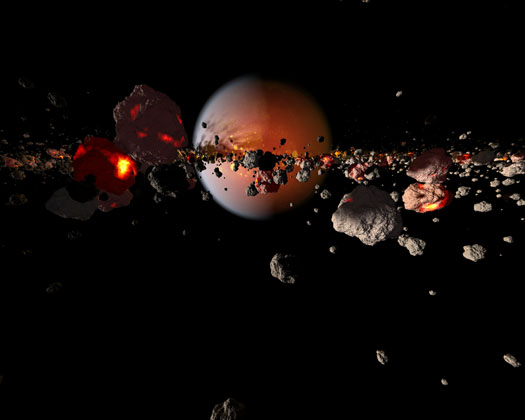

New simulations of a crash between Earth and a protoplanetary sister long ago could have produced a moon that’s chemically similar to our planet, according to a new analysis. It bolsters a theory that the moon is part of Earth, and it helps settle a question about how this could be physically possible.
Since around the time of the Apollo missions, lunar scientists have theorized that our moon formed after a horrendous collision between Earth and another world, which sheared off part of this planet. But all the while, there’s been a major disconnect with reality and the satisfying theoretical explanation of this concept. If that’s what happened, then the moon should be primarily composed of material from the collider, which would have been reincarnated as our natural satellite. Theoretical models and computer simulations of this catastrophic impact say the moon would be about 20 to 40 percent Earth parts and 60 to 80 percent non-Earth parts.
But the moon and the Earth have identical isotopes of key elements, proving the moon was made from Earth’s mantle. A host of theories have tried to explain this, even one suggesting that Earth generated its own internal thermonuclear reaction and blew itself apart.
Some scientists have suggested that Earth and moon material mixed together, so the Earth also contains some foreign matter. But very recent studies cast doubt on this, too. There was another problem in that Earth-sized planets should have been spinning faster than this one did, if that model is correct. Matija ?uk and colleagues at the SETI Institute started over, and envisioned a very fast-spinning Earth colliding with a smaller-than-Mars planet, nicknamed Theia.
In their computer simulations, which you can see in part below, it all works out. The moon can form from mostly Earth material, and a faster-spinning proto-Earth can lose some angular momentum thanks to tidal interactions with the sun, explaining its slower-than-expected speed.
In this animation, Earth and Theia are represented by the agglomerations of particles. Earth is spinning super-fast–its day is only 2.3 hours long. Theia, which has about half the mass of Mars, careens toward Earth at 44,740 MPH. It penetrates all the way to Earth’s core and excavates a massive hole in our planet, throwing material out in the process. Theia is mostly vaporized, along with part of our planet, and the iron from its core merges with Earth’s core.
Some material escapes Earth and forms a huge disk around it. The disk has almost no iron, but is made mostly of Earthly material. This would explain the moon’s composition, which very neatly matches that of Earth.
To test this hypothesis, a separate group of researchers ran further simulations with slower-moving impactors that were a little larger. This also produces a moon with the same chemical makeup as Earth’s mantle, they found. Taken together, the results suggest that our moon-formation theories may be spot on.
